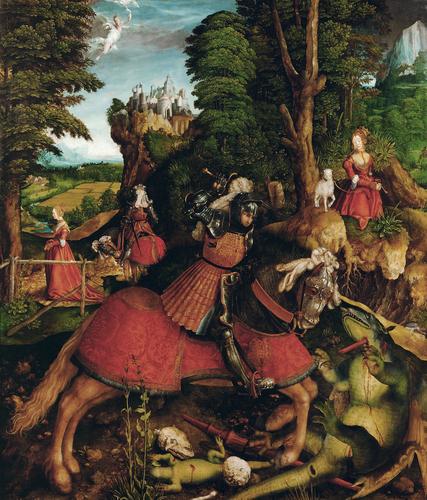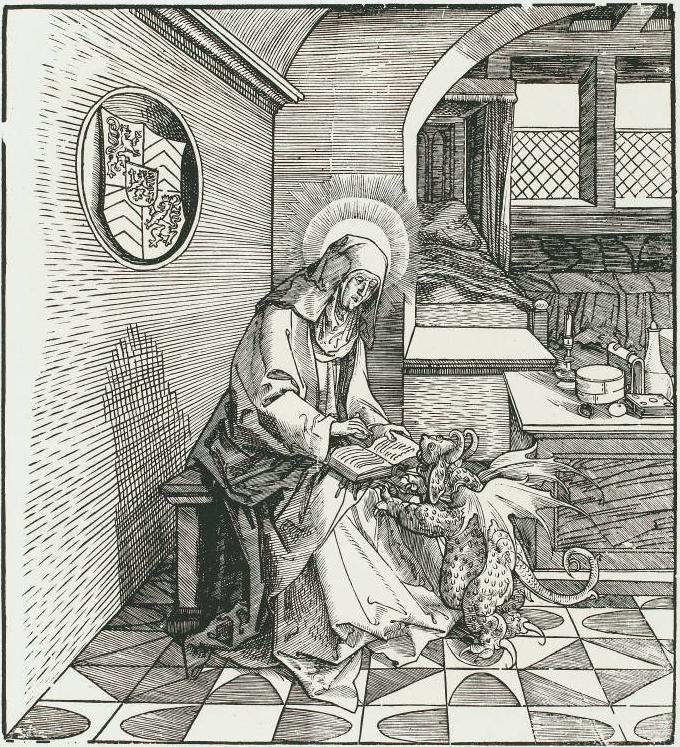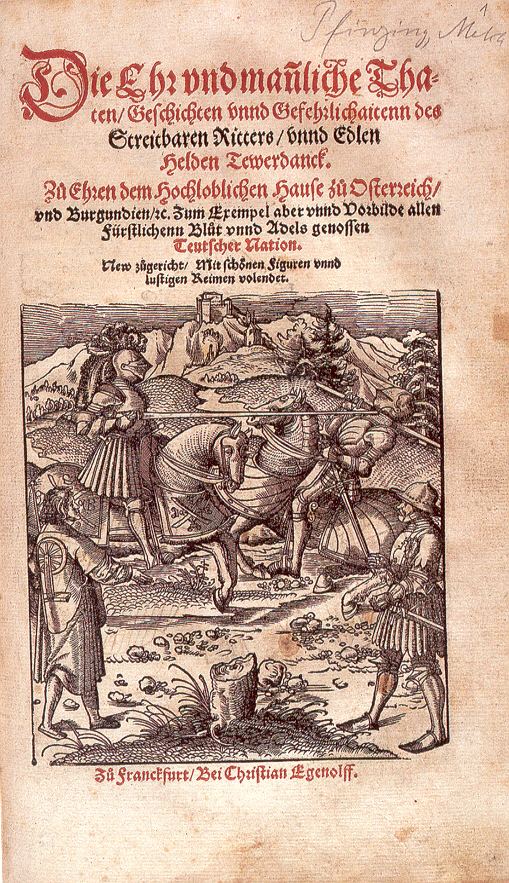|
Leonhard Beck
Leonhard Beck (c. 1480 – 1542) was a painter and designer of woodcuts in Augsburg, Germany. He was the son of Georg Beck, who was active as a miniaturist in Augsburg c. 1490-1512/15. He worked with his father on two Psalters for the Augsburg monastery in 1495. He was an assistant to Hans Holbein the Elder, working on a Holbein altarpiece now in the Städel in Frankfurt am Main in 1500-1501. His most notable work came when he joined the stable of artists, most in Augsburg, used by Emperor Maximilian I for his series of self-propagandising projects in or with woodcut. He was the main designer for the heavily illustrated poem '' Theuerdank'' (1517), producing 77 of the 118 woodcuts, and apparently all the many adjustments Maximilian required for the second edition in 1519. In these, his style often contrasts painfully with those of the better artists whose work he was altering. He designed 126 blocks for ''Der Weisskunig'' and 7 for the ''Triumphal Procession The ''Triumphal ... [...More Info...] [...Related Items...] OR: [Wikipedia] [Google] [Baidu] |
Leonhard Beck 001b (1921-2014), German author & historian
{{disambiguation ...
Leonhard may refer to: *Leonhard Euler (1707–1783), Swiss mathematician and physicist *Leonhard Hutter (1563–1616), German theologian *Karl Leonhard (1904–1988), German psychiatrist *Jim Leonhard (1982– ), American football safety *LEONHARD (2009– ), Oslo-based DJ collective *Leonhard Rauwolf (1535–1596), German physician and botanist * Leonhard Stejneger (1851–1943), American herpetologist *Wolfgang Leonhard Wolfgang Leonhard (16 April 1921 – 17 August 2014) was a German political author and historian of the Soviet Union, the German Democratic Republic and Communism. A German Communist whose family had fled Hitler's Germany and who was educated i ... [...More Info...] [...Related Items...] OR: [Wikipedia] [Google] [Baidu] |
Triumphal Procession
The ''Triumphal Procession'' (in German, ''Triumphzug'') or ''Triumphs of Maximilian'' is a monumental 16th-century series of woodcut prints by several artists, commissioned by the Holy Roman Emperor Maximilian I. The composite image was printed from over 130 separate wood blocks; a total of 139 are known. Approximately long, it is one of the largest prints ever produced. It was designed to be pasted to the walls in city halls or the palaces of princes to create a decorative frieze, an expression of the Emperor's power and magnificence: a pictorial form of the contemporaneous royal entry, which like many Renaissance entries looked back to the Roman triumph. Maximilian's papers show that he intended the procession to "grace the walls of council chambers and great halls of the empire, proclaiming for posterity the noble aims of their erstwhile ruler". It was one of several works of propaganda in literary and print form commissioned by Maximilian, who was always drastical ... [...More Info...] [...Related Items...] OR: [Wikipedia] [Google] [Baidu] |
16th-century German Painters
The 16th century begins with the Julian year 1501 ( MDI) and ends with either the Julian or the Gregorian year 1600 ( MDC) (depending on the reckoning used; the Gregorian calendar introduced a lapse of 10 days in October 1582). The 16th century is regarded by historians as the century which saw the rise of Western civilization and the Islamic gunpowder empires. The Renaissance in Italy and Europe saw the emergence of important artists, authors and scientists, and led to the foundation of important subjects which include accounting and political science. Copernicus proposed the heliocentric universe, which was met with strong resistance, and Tycho Brahe refuted the theory of celestial spheres through observational measurement of the 1572 appearance of a Milky Way supernova. These events directly challenged the long-held notion of an immutable universe supported by Ptolemy and Aristotle, and led to major revolutions in astronomy and science. Galileo Galilei became a champion ... [...More Info...] [...Related Items...] OR: [Wikipedia] [Google] [Baidu] |
German Printmakers
German(s) may refer to: * Germany (of or related to) **Germania (historical use) * Germans, citizens of Germany, people of German ancestry, or native speakers of the German language ** For citizens of Germany, see also German nationality law **Germanic peoples (Roman times) * German language German ( ) is a West Germanic language mainly spoken in Central Europe. It is the most widely spoken and official or co-official language in Germany, Austria, Switzerland, Liechtenstein, and the Italian province of South Tyrol. It is also a ... **any of the Germanic languages * German cuisine, traditional foods of Germany People * German (given name) * German (surname) * Germán, a Spanish name Places * German (parish), Isle of Man * German, Albania, or Gërmej * German, Bulgaria * German, Iran * German, North Macedonia * German, New York, U.S. * Agios Germanos, Greece Other uses * German (mythology), a South Slavic mythological being * Germans (band), a Canadian rock band * Ger ... [...More Info...] [...Related Items...] OR: [Wikipedia] [Google] [Baidu] |
German Draughtsmen
German(s) may refer to: * Germany (of or related to) ** Germania (historical use) * Germans, citizens of Germany, people of German ancestry, or native speakers of the German language ** For citizens of Germany, see also German nationality law **Germanic peoples (Roman times) * German language **any of the Germanic languages * German cuisine, traditional foods of Germany People * German (given name) * German (surname) * Germán, a Spanish name Places * German (parish), Isle of Man * German, Albania, or Gërmej * German, Bulgaria * German, Iran * German, North Macedonia * German, New York, U.S. * Agios Germanos, Greece Other uses * German (mythology), a South Slavic mythological being * Germans (band), a Canadian rock band * "German" (song), a 2019 song by No Money Enterprise * ''The German'', a 2008 short film * "The Germans", an episode of ''Fawlty Towers'' * ''The German'', a nickname for Congolese rebel André Kisase Ngandu See also * Germanic (disambiguation ... [...More Info...] [...Related Items...] OR: [Wikipedia] [Google] [Baidu] |
Artists From Augsburg
An artist is a person engaged in an activity related to creating art, practicing the arts, or demonstrating an art. The common usage in both everyday speech and academic discourse refers to a practitioner in the visual arts only. However, the term is also often used in the entertainment business, especially in a business context, for musicians and other performers (although less often for actors). "Artiste" (French for artist) is a variant used in English in this context, but this use has become rare. Use of the term "artist" to describe writers is valid, but less common, and mostly restricted to contexts like used in criticism. Dictionary definitions The ''Oxford English Dictionary'' defines the older broad meanings of the term "artist": * A learned person or Master of Arts. * One who pursues a practical science, traditionally medicine, astrology, alchemy, chemistry. * A follower of a pursuit in which skill comes by study or practice. * A follower of a manual art, such a ... [...More Info...] [...Related Items...] OR: [Wikipedia] [Google] [Baidu] |
1542 Deaths
Year 154 ( CLIV) was a common year starting on Monday (link will display the full calendar) of the Julian calendar. At the time, it was known as the Year of the Consulship of Aurelius and Lateranus (or, less frequently, year 907 ''Ab urbe condita''). The denomination 154 for this year has been used since the early medieval period, when the Anno Domini calendar era became the prevalent method in Europe for naming years. Events By place Roman Empire * King Eupator of Bosphorus pays tribute to Rome, due to the threat posed by the Alani. * The Antonine Wall is completed. Asia * Last (2nd) year of ''Yongxing'' era of the Chinese Han Dynasty. * Adalla becomes ruler of the Korean kingdom of Silla. By topic Religion * Anicetus becomes pope of Rome (approximate date). * Anicetus meets with Polycarp of Smyrna to discuss the Computus, the date of Easter in the Christian liturgical calendar. * Change of Patriarch of Constantinople from Patriarch Euzois to Patriarch Laur ... [...More Info...] [...Related Items...] OR: [Wikipedia] [Google] [Baidu] |
1480 Births
*
{{Number disambiguation ...
148 may refer to: *148 (number), a natural number *AD 148, a year in the 2nd century AD *148 BC, a year in the 2nd century BC *148 (album), an album by C418 *148 (Meiktila) Battery Royal Artillery *148 (New Jersey bus) See also * List of highways numbered 148 The following highways are numbered 148: Argentina * National Route 148 Canada * New Brunswick Route 148 * Ontario Highway 148 * Prince Edward Island Route 148 * Quebec Route 148 Costa Rica * National Route 148 India * National Highway 14 ... [...More Info...] [...Related Items...] OR: [Wikipedia] [Google] [Baidu] |
Abbey Of Maubeuge
Maubeuge Abbey (french: Abbaye de Maubeuge) was a women's monastery in Maubeuge, in the County of Hainaut, now northern France, close to the modern border with Belgium. It is best known today as the abbey founded by St. Aldegonde, still a popular figure of devotion in the region. It is thought to have possibly been where the young Jan Gossaert, a Renaissance-era painter known as Jan Mabuse, was educated, claimed by some to have been a native of the town of Maubeuge, which grew up around the abbey. History Initially founded as a double monastery, that is, a community of both men and women, this abbey was founded in 661 for the care of the sick by the young Aldegonde, who was abbess there until her death in 684, and was also buried there. She was succeeded as abbess by her two nieces, first Aldetrudis and then Madelberte. The abbey soon became a Benedictine monastery solely of nuns. St. Amalberga of Maubeuge became a member of the community later in the eighth century. Maubeug ... [...More Info...] [...Related Items...] OR: [Wikipedia] [Google] [Baidu] |
Der Weisskunig
''Der Weisskunig'' or ''The White King'' is a chivalric novel and thinly disguised biography of the Holy Roman Emperor, Maximilian I, (1486–1519) written in German by Maximilian and his secretary between 1505 and 1516. Although not explicitly identified as such in the book, Maximilian appears as the "young" White King, with his father Frederick III represented as the "old" White King. The book is now mainly remembered for the 251 woodcut illustrations, made in Augsburg between 1514 and 1516, the principal artists for which were Hans Burgkmair and Leonhard Beck. The work was never completed, and the full published edition did not appear until 1775. Background Maximilian I, and his father Frederick III, were part of what was to become a long line of Holy Roman Emperors from the House of Habsburg. Maximilian was elected King of the Romans in 1486 and succeeded his father on his death in 1493. During his reign Maximilian commissioned a number of humanist scholars and art ... [...More Info...] [...Related Items...] OR: [Wikipedia] [Google] [Baidu] |
Woodcut
Woodcut is a relief printing technique in printmaking. An artist carves an image into the surface of a block of wood—typically with gouges—leaving the printing parts level with the surface while removing the non-printing parts. Areas that the artist cuts away carry no ink, while characters or images at surface level carry the ink to produce the print. The block is cut along the wood grain (unlike wood engraving, where the block is cut in the end-grain). The surface is covered with ink by rolling over the surface with an ink-covered roller ( brayer), leaving ink upon the flat surface but not in the non-printing areas. Multiple colors can be printed by keying the paper to a frame around the woodblocks (using a different block for each color). The art of carving the woodcut can be called "xylography", but this is rarely used in English for images alone, although that and "xylographic" are used in connection with block books, which are small books containing text and images i ... [...More Info...] [...Related Items...] OR: [Wikipedia] [Google] [Baidu] |
Theuerdank
''Theuerdank'' (''Teuerdank, Tewerdanck, Teuerdannckh'') is a poetic work composed by Maximilian I, Holy Roman Emperor, the Holy Roman Emperor, Maximilian I, (1486-1519) in German which tells the fictionalised and romanticised story of his journey to marry Mary of Burgundy in 1477. The published poem was accompanied by 118 woodcuts designed by the artists Leonhard Beck, Hans Burgkmair, Hans Leonhard Schäufelein, Hans Schäufelein and others.Bartrum, 147 Its newly designed blackletter typeface was influential. The full title in the first (1517) edition is ''Die geverlicheiten vnd einsteils der geschichten des loblichen streytparen vnd hochberümbten helds vnd ritters herr Tewrdannckhs'' ("The adventures and part of the stories of the praiseworthy, valiant and most famous hero and knight, lord Teuerdank"). Background Maximilian I, Holy Roman Emperor, Maximilian I, and his father Frederick III, Holy Roman Emperor, Frederick III, were part of what was to become a long line of Holy ... [...More Info...] [...Related Items...] OR: [Wikipedia] [Google] [Baidu] |






